Key takeaways
- Sedona’s vortexes are perceived as powerful energy centers, enhancing the sensory experience of photographers and visitors.
- Essential photography equipment includes a sturdy tripod, wide-angle lens, and polarizing filter to capture the unique light and colors of the landscape.
- The best times for photography are during golden hours and nighttime, while adapting to midday conditions can spark creativity.
- Editing techniques involve balancing contrast, avoiding over-saturation, and using subtle adjustments to convey the energy and emotion of the vortexes.
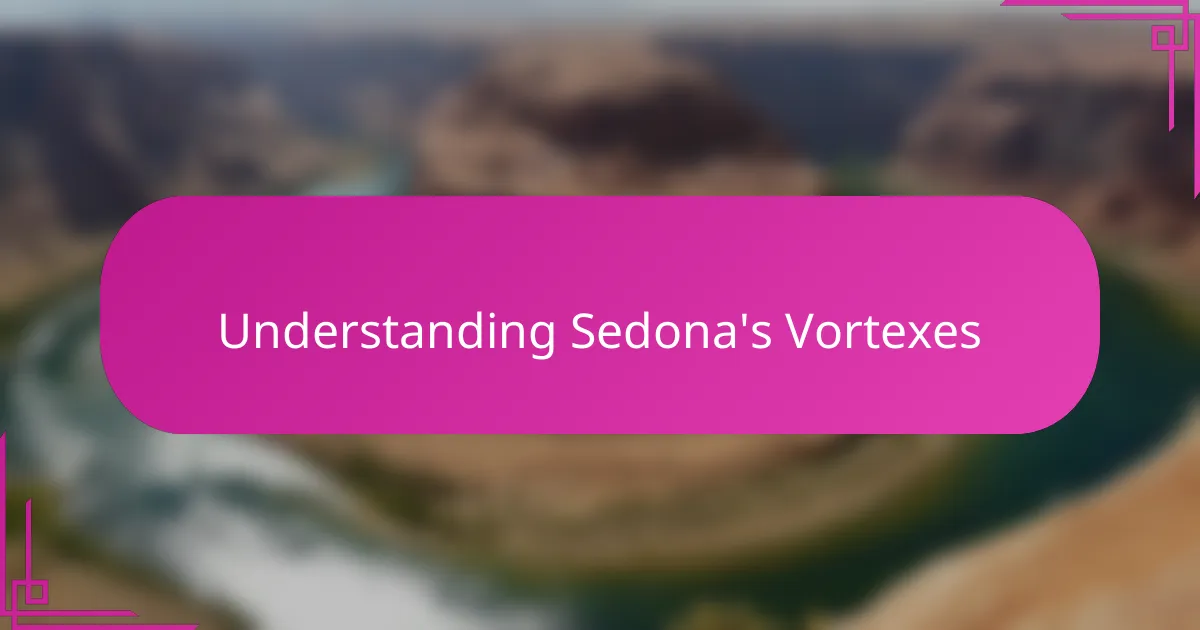
Understanding Sedona’s Vortexes
Sedona’s vortexes have always fascinated me, not just as natural formations but as powerful energy centers that many say influence the mind and spirit. Have you ever stood in a place where the air seems charged, almost alive? That subtle shift in atmosphere is what draws photographers and seekers alike to these unique spots.
From my own experience, the vortexes feel like invisible whirlpools of energy swirling around the red rocks, creating an almost magnetic pull. It’s hard to explain if you haven’t felt it yourself, but when I’m there, my senses sharpen and I notice details I would normally overlook—like the way light dances differently against the rugged landscape.
Why do these vortexes hold such power over so many? I believe it’s partly the stunning visual backdrop combined with something deeper, an intangible connection between nature and spirit. Understanding this helps me capture more than just a picture—I try to convey the feeling of being in a place alive with energy.
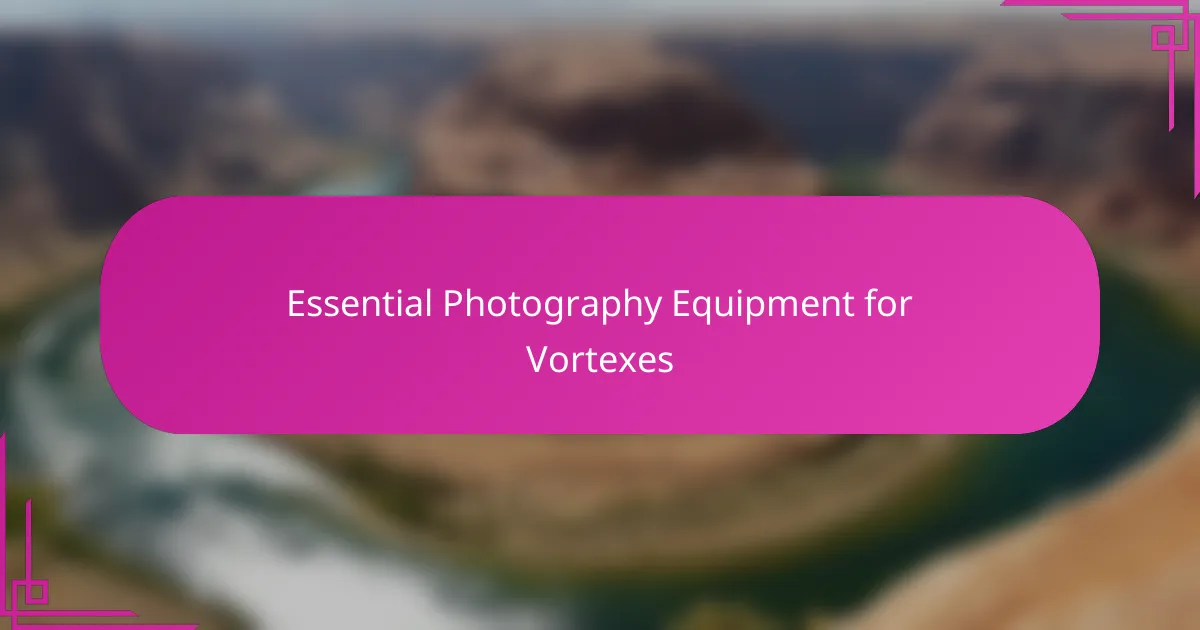
Essential Photography Equipment for Vortexes
When I head out to photograph Sedona’s vortexes, my camera and tripod are absolute essentials. The shifting light around these energy hotspots plays tricks—it demands stability and precision, so a sturdy tripod keeps my shots sharp even in low light or long exposures. Without it, I’d miss capturing that ethereal glow that seems to emanate from the rocks themselves.
I’ve found that a wide-angle lens is my go-to for these scenes. It lets me embrace the grandeur of the landscape and the swirling energy all at once. Have you ever tried squeezing the vast openness of Sedona’s red rocks into a frame? It’s challenging, but that lens helps me convey the vastness and mystery that’s so vital to feeling the vortex’s power.
Another piece of gear I can’t overlook is a polarizing filter. It sounds technical, but it basically helps tame reflections and bring out those rich, deep colors that Sedona is famous for. I remember one afternoon when the midday sun was harsh, and that filter turned otherwise flat-looking skies into vibrant backdrops. Small tools like that can really transform a snapshot into something more soulful.
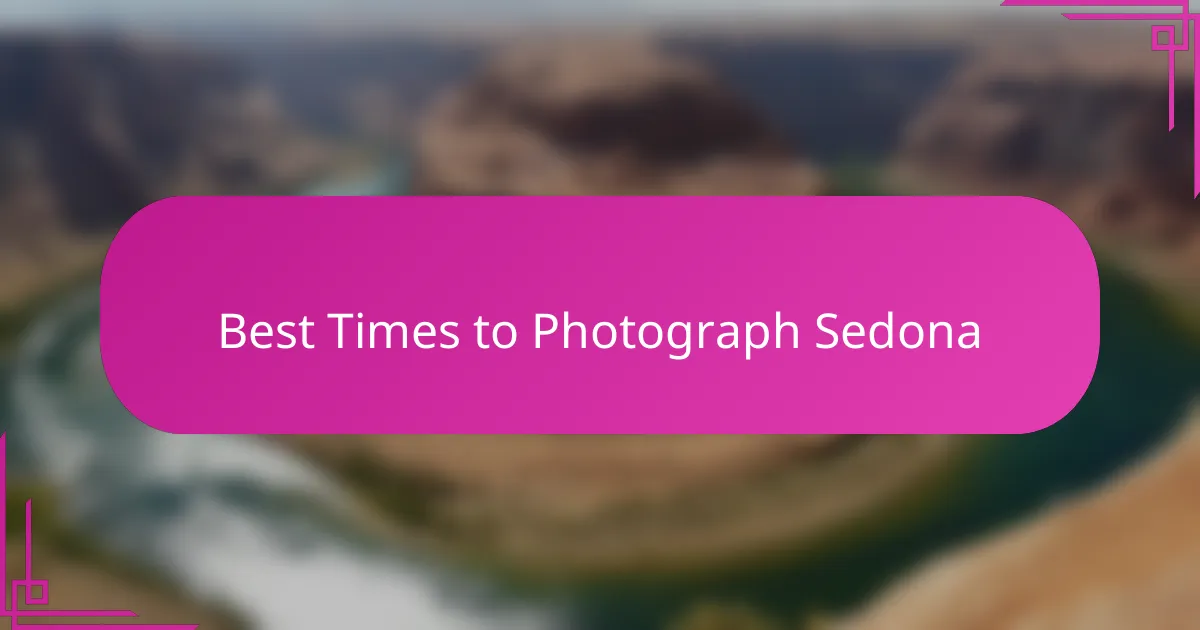
Best Times to Photograph Sedona
Timing your visit to Sedona can make all the difference in capturing the vortexes’ true essence. From my experience, the golden hours—shortly after sunrise and just before sunset—offer the most magical light. Have you ever noticed how the red rocks almost seem to glow then? That warm, soft light enhances their texture and makes each shot feel almost alive.
Midday can be tricky with harsh sunlight flattening the landscape, but I’ve learned to work with those conditions too. On bright days, I wait for clouds to diffuse the light or use a polarizing filter to cut glare, bringing out those intense reds I adore. It’s not always ideal, but sometimes challenging light pushes me to get creative in ways I hadn’t planned.
Nighttime is another secret I’ve come to appreciate, especially under a clear sky. Have you ever tried long exposures capturing the stars swirling above Cathedral Rock? The stillness and cosmic backdrop add a mystical layer to the vortexes, connecting earth and sky in a way that daylight simply can’t. For me, those nocturnal shots tell a different story—quiet, powerful, and deeply personal.
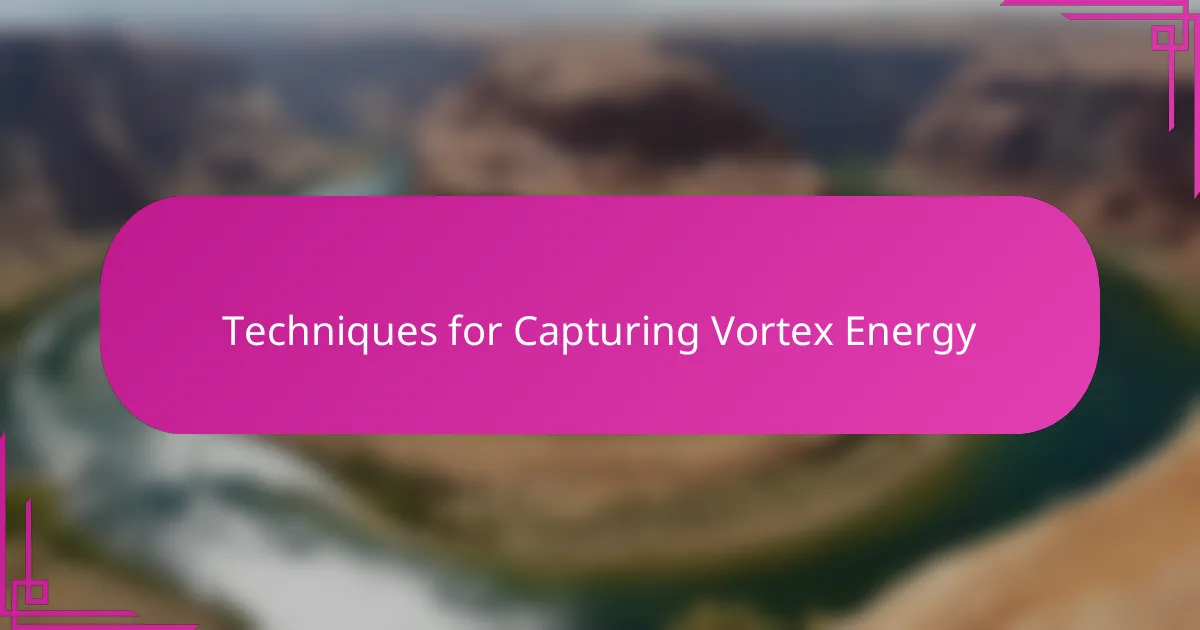
Techniques for Capturing Vortex Energy
Capturing vortex energy is less about snapping a perfectly framed landscape and more about tuning into the subtle movements of light and shadow that seem to ripple around these powerful spots. I often slow my shutter speed just enough to blur the gentle swirls of wind or leaves, letting the camera mimic the invisible flows of energy I feel. Have you noticed how sometimes the smallest motion can convey the greatest sense of presence?
I like to experiment with composition by positioning myself low to the ground or shooting upwards toward the sky, inviting the vortex’s spiral into the frame. This perspective shift, for me, echoes the upward pull of energy and invites viewers to feel drawn into the scene rather than just looking at it. It’s a small technique, but it changes the whole emotional tone of the photo.
The interplay between natural light and the landscape plays a huge role too. At times, I catch sunlight filtering through red rock alcoves, creating shafts of light that feel like physical manifestations of vortex energy. Waiting patiently for those fleeting moments can be frustrating, but when it happens, it’s pure magic—a reminder that some energies are visible if you’re willing to see them.
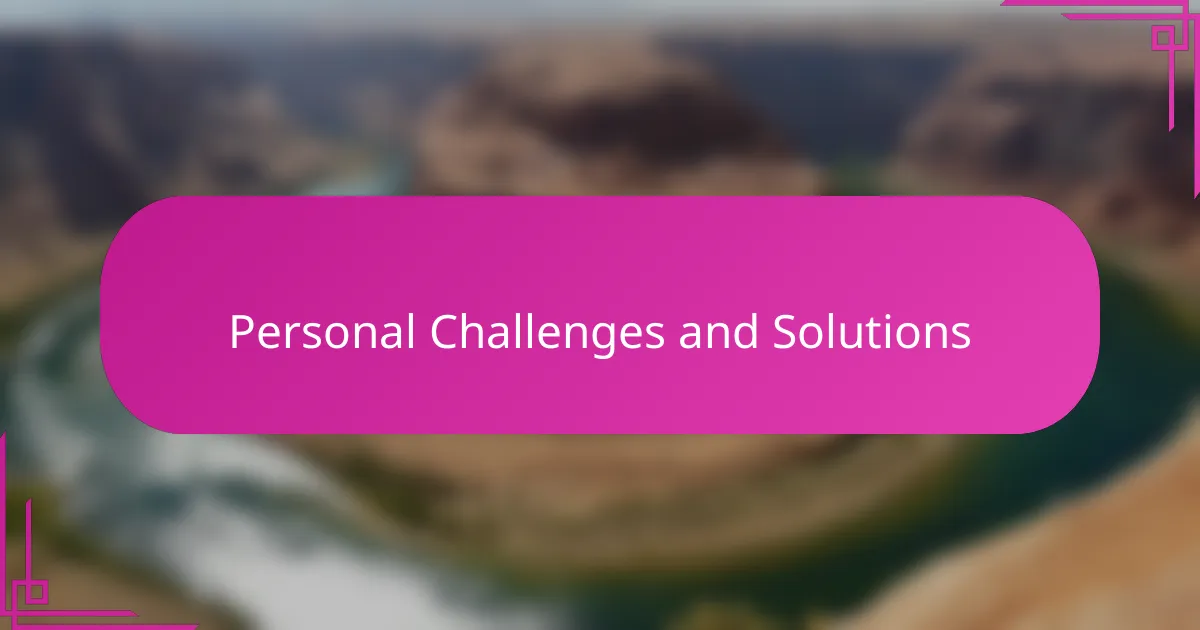
Personal Challenges and Solutions
One challenge I faced early on was capturing the elusive energy of the vortexes without getting distracted by technical worries. Have you ever found yourself so focused on settings that you miss the moment? I learned to balance technical precision with being present in the scene, which helped me create photos that truly resonate beyond just visuals.
Another hurdle was dealing with unpredictable weather conditions. Sedona’s light can change rapidly, and I remember a shoot interrupted by sudden winds that whipped up dust and made stabilizing my tripod tricky. My solution? Embrace those moments by using them to convey movement and raw energy rather than fight them—a shift in mindset that transformed stressful shoots into creative opportunities.
Lastly, I struggled initially with conveying the vortex feeling in a two-dimensional image. How do you capture something invisible yet deeply felt? Over time, I experimented with slower shutter speeds and unique angles to suggest motion and depth, which, for me, unlocked a way to translate the vortex’s spirit into photos that invite viewers to feel what I was experiencing.
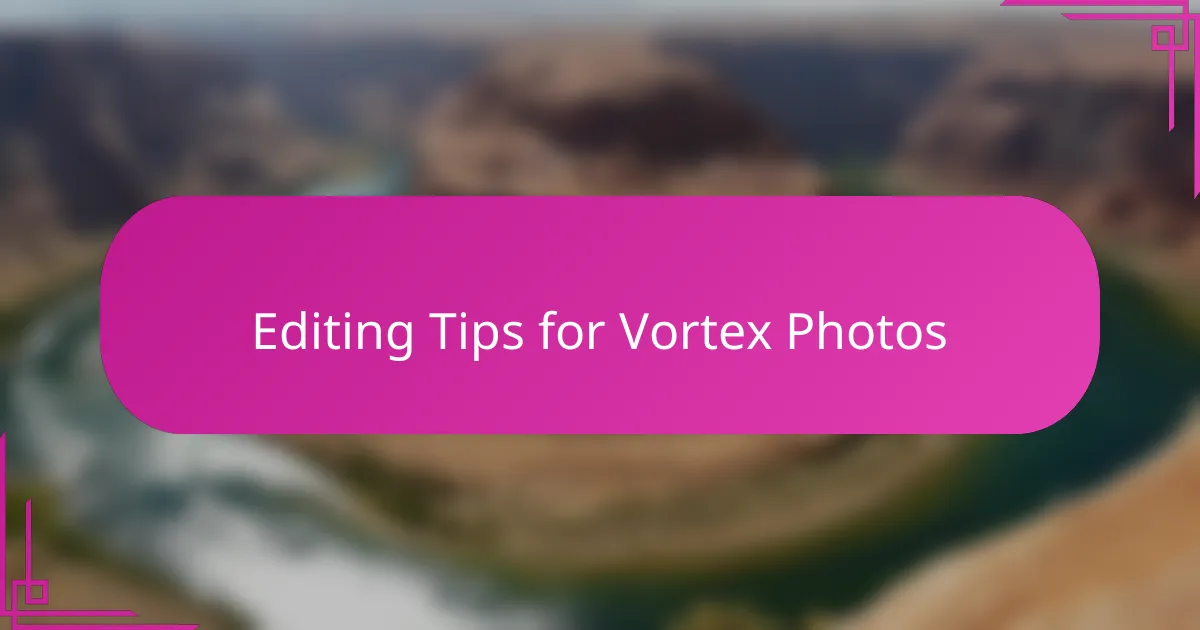
Editing Tips for Vortex Photos
Editing vortex photos is where I really get to bring out that unseen energy swirling in the frame. Have you ever tried boosting contrast just enough to make the reds pop without losing the soft shadows that hint at movement? It’s a delicate balance—too much, and the photo looks harsh; too little, and the magic feels muted.
I often play with subtle vignettes to gently draw the eye toward the center, mimicking the pull of the vortex itself. Sometimes, I’ll add a touch of clarity or dehaze in spots to emphasize the texture of the red rocks, which, for me, feels like revealing the landscape’s hidden heartbeat. These small adjustments can transform a simple shot into something that resonates emotionally.
One tip I’ve found invaluable is to avoid over-saturating the colors. When I first started editing, I was tempted to crank up the reds, thinking it would capture the intensity. But the real power lies in preserving the natural tones and letting the light’s drama tell the story. How do you keep that authenticity while still enhancing the scene? For me, it’s about subtlety and restraint in every edit.
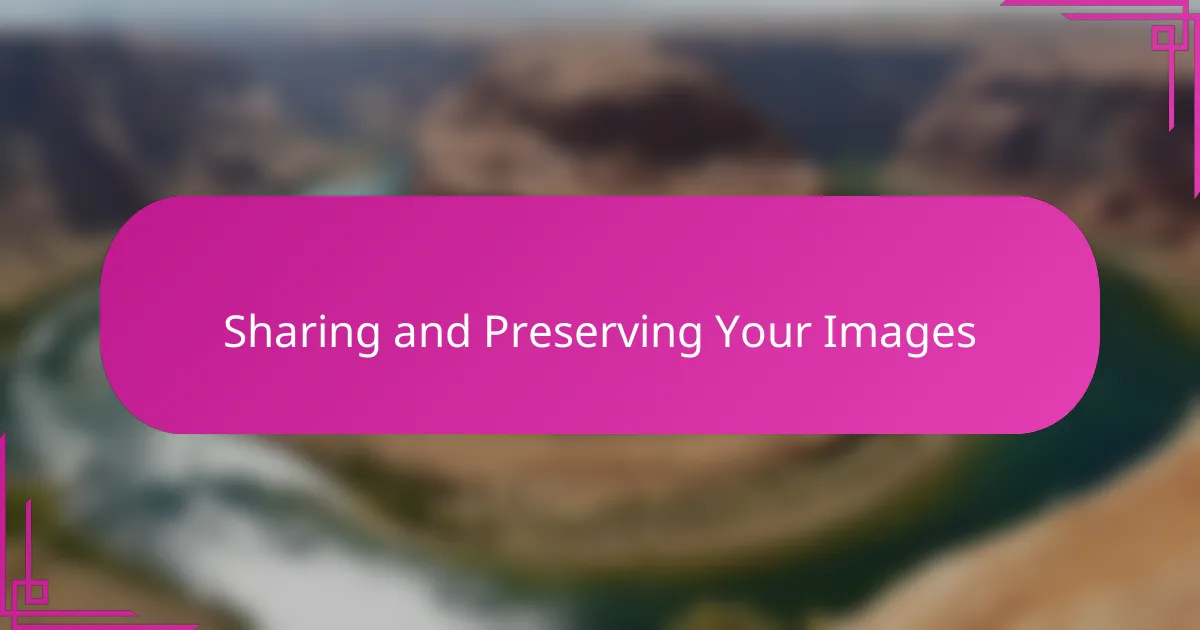
Sharing and Preserving Your Images
Sharing your images feels like extending the experience of Sedona’s vortexes beyond just your own senses. Have you ever hesitated, wondering if a photo truly captures what you felt? I find that sharing with a community—whether through social media or local photo groups—invites others to connect with those moments and often sparks meaningful conversations about the energy we’re all drawn to.
Preserving these images goes beyond archiving files; it’s about safeguarding those fleeting impressions that might otherwise fade with time. I’ve learned the value of backing up my photos in multiple places—cloud storage, external drives—to ensure that a sudden glitch doesn’t erase memories tied to a particular moment of inspiration or revelation. Do you have a system to protect your work from loss?
And when it comes to printing, nothing beats holding a tangible print of a vortex shot in your hands. I recall the excitement of seeing one of my favorite Sedona photos enlarged and displayed—it made the feeling of that place so much more immediate, as if the energy was radiating right off the paper. Have you experienced how printed images can preserve not just pixels, but emotion?